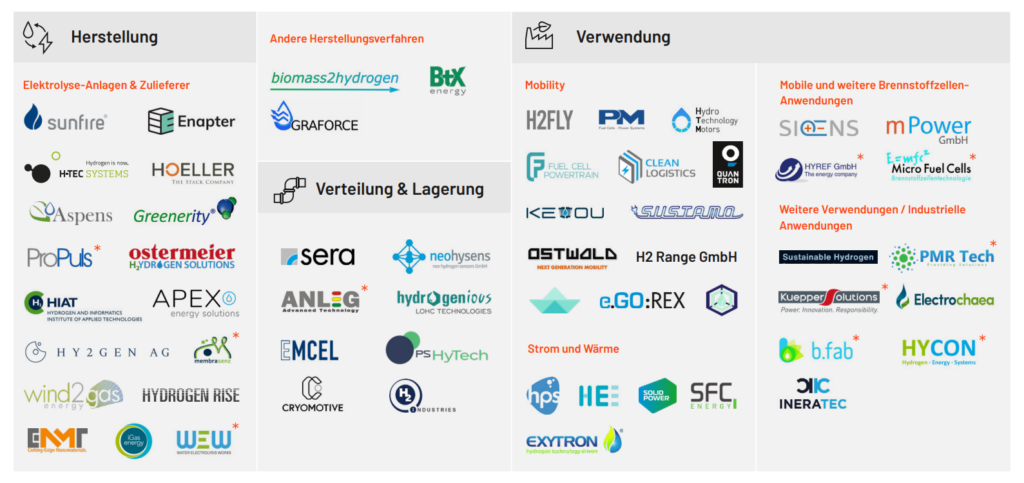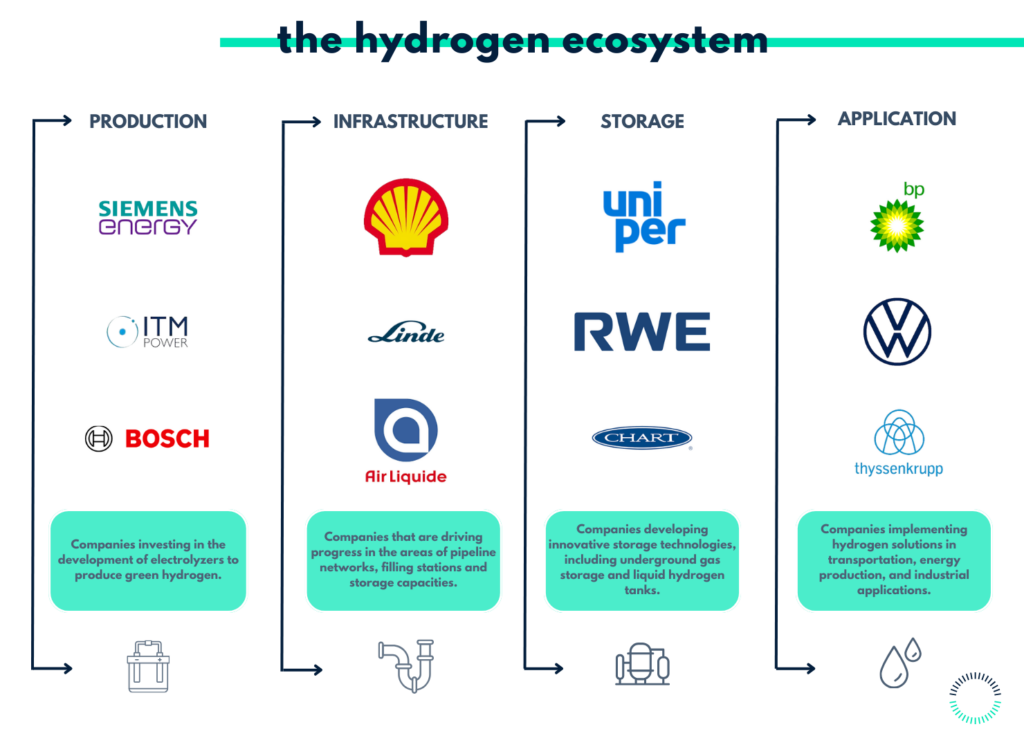Hydrogen: Light Element, Heavy Investments

💧 Hydrogen (H2) is emerging as a cornerstone in transitioning to a sustainable energy future. As the universe’s lightest and most abundant element, it offers unparalleled potential across various sectors. This deep dive explores the current landscape of hydrogen investments, the technological advancements driving the sector, and the strategic initiatives shaping its future.
Colorless, odorless, and non-toxic, hydrogen exists in a gaseous state at room temperature. In diverse applications, it has the potential to be utilized as a clean energy carrier or fuel in transportation, industry, and power generation. This capability allows for sector coupling and the decarbonization of the economy. Derived from various sources, particularly using renewable energy such as solar and wind, it enables flexible and sustainable energy storage and utilization.
Improving the entire hydrogen value chain, including production, storage, distribution, and utilization, is crucial.
Given the central role of hydrogen in decarbonization, numerous research fields and startups are emerging to bring innovative technologies to market along the value chain.

🌱 Green Hydrogen: A Fuel for a Green Future?
Different methods are applied in hydrogen production, each with distinct environmental impacts. Green hydrogen, produced through the electrolysis of water using solely renewable energy, is considered the most environmentally friendly option. Other types of hydrogen vary according to their production methods:
- Turquoise hydrogen is generated by thermally splitting methane, producing solid carbon instead of CO2.
- Blue hydrogen is created through natural gas reforming, with the resultant CO2 being captured and stored.
- Orange hydrogen is derived from waste and residual materials, making it a more sustainable option from the input side.
- Gray hydrogen is produced via steam reforming of fossil natural gas sources and is therefore carbon-intensive.
Continuous advancements in the efficiency of electrolysis processes are essential to drive large-scale hydrogen production. Simultaneously, reducing the costs of fuel cell systems is significant for making their application more economically viable. Investments are needed to further develop key components like membranes for Proton Exchange Membrane (PEM) electrolysis and fuel cells.
⚡ Empowering Industry: Leading the Charge
Investment trends are evidenced by leading companies such as Siemens Energy, Uniper, RWE, and Bosch, with Bosch alone planning to invest up to €2.5 billion in building a hydrogen economy. Other major players in the energy sector, such as Shell, are planning to invest up to $1 billion annually in hydrogen and carbon capture and storage (CCS) in 2024 and 2025, while BP aims to allocate $10 billion by the end of the decade for the transformation into an integrated energy company.
Current large-scale projects include investments in a 10-megawatt electrolyzer for hydrogen production and the expansion of a biomethane liquefaction facility in the Rhine region. Hydrocrackers play a vital role by converting heavy, low-quality hydrocarbons into lighter, high-quality products. An even larger project is underway in Lingen, involving the installation of a 100-megawatt electrolyzer. Given the expectation that sufficient domestic H2 production may not be feasible soon, the construction of an ammonia import terminal in Wilhelmshaven is being considered. Overall, various green hydrogen projects with capacities ranging from 500,000 to 700,000 tons annually are in the planning stages.
Investments are also flowing into the establishment of production capacity for innovative electrolyzers, such as the use of PEM electrolyzers with an annual capacity of 8,000 tons, developed in collaboration with Siemens Energy.

🌍 Future is Green
In Europe and the USA, there is potential to play a significant role as net exporters of H2. While the USA is aligning its strategy to increase production and usage while promoting innovation through generous investments, Europe is striving for regulatory unity. This includes standardizing hydrogen technologies and infrastructure to create a transparent and efficient market environment. Additionally, uniform incentives and funding programs across various EU countries are aimed at attracting investments and facilitating cross-border collaboration.
In Germany, the Federal Ministry for Economic Affairs and Energy (BMWK) is taking steps to promote the hydrogen economy. Here are some examples:
- National Hydrogen Core Network: A hydrogen core network is set to be established by 2032, covering nearly 10,000 kilometers. Existing natural gas pipelines will be converted, and new lines will be built to connect key hydrogen sites such as industrial centers, storage facilities, power plants, and import corridors.
- Funding Guidelines for International Hydrogen Projects: In October 2021, the BMWK and the Federal Ministry of Education and Research (BMBF) published funding guidelines to financially support international hydrogen projects. This initiative supports the establishment of production facilities for green hydrogen and its derivatives, as well as the storage, transport, and integrated application of hydrogen outside the EU and EFTA states.
- Flexible Governance Structure: A flexible and results-oriented governance structure has been created to consistently implement and further develop the National Hydrogen Strategy, with the National Hydrogen Council at its center.
These measures aim to accelerate the market ramp-up of hydrogen technologies, strengthen the competitiveness of German companies, and position Germany as a leading provider of hydrogen technologies. Transmission system operators such as OGE, ONTRAS, and GASCADE play a crucial role in expanding green hydrogen infrastructure in Germany.
“Light Element, Heavy Investments” perfectly encapsulates the current landscape, as the Dresden-based electrolyzer startup Sunfire recently raised €500 million. Other companies like Lhyfe, Hysetco, H2 Green Steel, and Corre Energy are also receiving significant financial backing, highlighting their substantial economic potential.

The investments from large corporations, key players in Germany and the EU, along with well-funded startups across the hydrogen value chain, clearly indicate that this field represents an attractive opportunity not only for established companies but also for venture capitalists. The diversity of investments, spanning from production to infrastructure, suggests a growing interest and confidence in the future of the hydrogen sector.
______________________________
📌 Summary of the Article
- Hydrogen (H2) is pivotal for achieving sustainable energy solutions, with diverse applications in transportation, industry, and power generation.
- Various production methods exist, notably green hydrogen, which is the most environmentally friendly option.
- Significant investments are flowing into the hydrogen economy from major corporations like Bosch, Shell, and BP, with large-scale projects and innovative technologies under development.
- Regulatory efforts in Europe and the U.S. aim to establish a cohesive hydrogen market.
- Germany’s proactive measures, including the National Hydrogen Core Network, position it as a leader in hydrogen technologies.
- The sector presents substantial opportunities for both established companies and venture capitalists.
_____________________________________
At DeepTech & Climate Fonds (DTCF), we are also closely monitoring this field and actively seeking suitable startups. With our fund volume of up to €1 billion, we are not afraid of capital-intensive investments. We are interested in early growth rounds and look forward to engaging with startups and investors.
👉 This article was written by Cristina Doumitrachko.